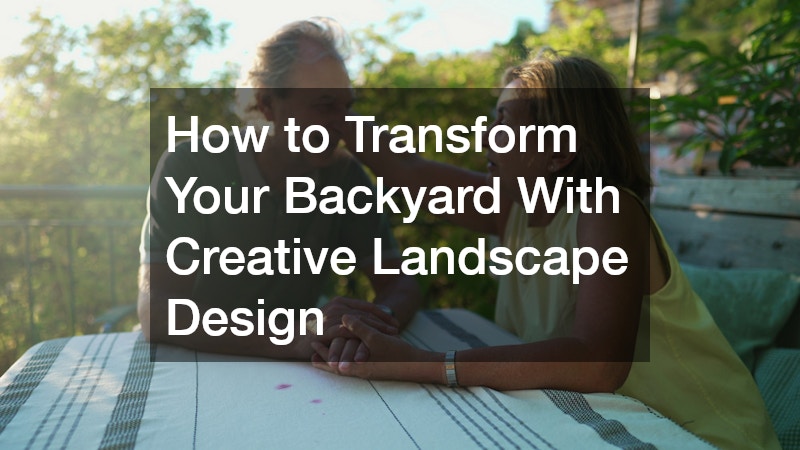A backyard is more than just a patch of land behind your home—it’s an extension of your living space, a sanctuary for relaxation, and a canvas for creativity. With thoughtful landscape design, even the simplest backyard can be transformed into a visually stunning and functional outdoor retreat. Whether you’re working with a small urban yard or a sprawling suburban garden, creative landscape design can help you maximize space, add aesthetic appeal, and create an inviting environment for family, friends, and wildlife.
Understanding the Basics of Landscape Design
Before diving into plants and decorations, it’s important to understand the fundamentals of landscape design. Landscape design combines art and science to create outdoor spaces that are visually appealing, practical, and sustainable. Key principles include:
-
Balance: Ensuring visual harmony by evenly distributing elements such as plants, pathways, and furniture. Balance can be symmetrical (formal and structured) or asymmetrical (natural and relaxed).
-
Scale and Proportion: Choosing plants, trees, and structures that fit the size of your backyard. Oversized elements in a small space can feel overwhelming, while tiny features in a large yard may seem out of place.
-
Focal Points: Creating areas that draw attention, such as a water feature, a striking plant, or a decorative sculpture. Focal points guide the eye and provide visual interest.
-
Unity and Cohesion: Selecting elements that complement each other in style, color, and texture to ensure the design feels cohesive rather than cluttered.
Understanding these principles helps you make design choices that are both practical and visually appealing.
Plan Your Layout
A well-thought-out layout is the foundation of any successful landscape design. Begin by mapping your backyard, taking note of existing features such as trees, slopes, and structures. Consider how you want to use the space, whether for entertaining, gardening, relaxation, or play, and then organize it accordingly. One effective approach is to divide the backyard into functional zones, allowing areas for dining, lounging, playing, or gardening to coexist harmoniously. Pathways can be incorporated to guide movement through the space, with materials like stone, gravel, or wooden planks adding texture and charm while making navigation easy. Privacy can also be enhanced by using hedges, fences, trellises, or tall plants, which create intimate spaces without blocking natural light.
Choose Plants Strategically
Plants are the heart of any landscape design. The right combination of trees, shrubs, flowers, and ground covers can provide color, texture, and seasonal interest.
-
Layering: Plant in layers with taller trees and shrubs in the back and shorter plants in the front. This technique adds depth and dimension to your backyard.
-
Color Palette: Select plants that complement each other in color. Consider seasonal blooms to maintain year-round appeal.
-
Native Plants: Incorporate native species that thrive in your local climate. They require less maintenance, attract wildlife, and support biodiversity.
-
Evergreens and Perennials: Combine evergreens for year-round structure with perennials for bursts of seasonal color.
Incorporate Creative Features
Adding unique features can elevate your backyard from ordinary to extraordinary by engaging all the senses and enhancing its functionality. Water features, such as small ponds, fountains, or waterfalls, can create a calming atmosphere while attracting birds and other wildlife. Thoughtfully placed outdoor lighting—like solar lights, string lights, or lanterns—extends the usability of your backyard into the evening and highlights key design elements. Fire pits encourage gatherings, while built-in benches or cozy seating areas provide comfortable spaces for relaxation. For smaller yards, vertical gardening or trellises can maximize planting space and add visual interest, allowing you to make the most of every inch without feeling cramped.
Embrace Hardscaping
Hardscaping refers to the non-plant elements of your backyard, such as patios, decks, fences, and retaining walls. These features not only provide structure but also enhance functionality.
-
Patios and Decks: Define outdoor living spaces for dining, lounging, or entertainment. Materials like wood, stone, or composite decking can suit different aesthetics.
-
Retaining Walls and Terracing: If your backyard has slopes, retaining walls can prevent erosion while creating planting terraces.
-
Pathways and Walkways: Well-designed walkways guide movement and reduce wear on grassy areas.
Add Personal Touches
Finally, infuse your backyard with personality. Decorative elements such as garden sculptures, birdbaths, or colorful pots can make the space uniquely yours. Consider your lifestyle—if you love reading, a hammock or quiet nook may be ideal; if you entertain often, a large dining area or outdoor kitchen could be the focal point.
Transforming your backyard with creative landscape design is a rewarding process that combines planning, creativity, and ongoing care. By understanding design principles, planning your layout, choosing plants strategically, and incorporating both softscape and hardscape elements, you can create a backyard that is functional, beautiful, and uniquely yours. With a little effort and imagination, your outdoor space can become a sanctuary that enhances your home and enriches your daily life.

